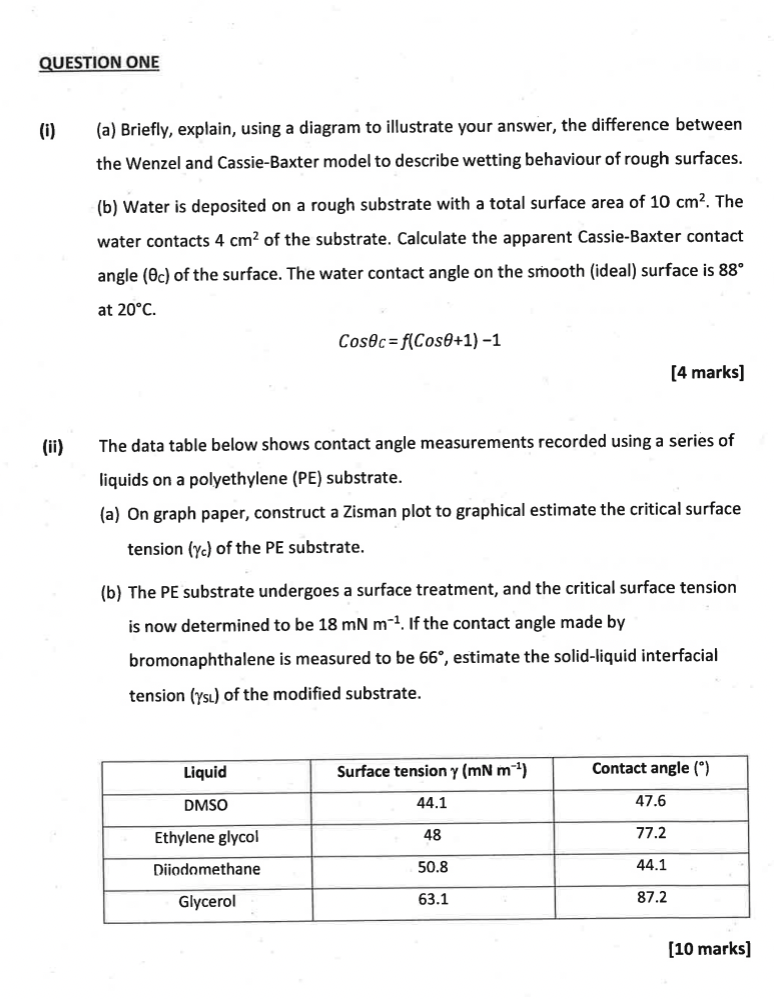(i) (a) Briefly explain, using a diagram to illustrate your answer, the difference between the Wenzel and Cassie-Baxter model to describe wetting behavior of rough surfaces. (b) Wa... (i) (a) Briefly explain, using a diagram to illustrate your answer, the difference between the Wenzel and Cassie-Baxter model to describe wetting behavior of rough surfaces. (b) Water is deposited on a rough substrate with a total surface area of 10 cm². The water contacts 4 cm² of the substrate. Calculate the apparent Cassie-Baxter contact angle. The water contact angle on the smooth (ideal) surface is 88° at 20°C. Cos θc = f(Cos θ + 1) − 1 [4 marks] (ii) The data table below shows contact angle measurements recorded using a series of liquids on a polyethylene (PE) substrate. (a) On graph paper, construct a Zisman plot to graphically estimate the critical surface tension (γc) of the PE substrate. (b) The PE substrate undergoes a surface treatment, and the critical surface tension is now determined to be 18 mN m−1. If the contact angle made by bromonaphthalene is measured to be 66°, estimate the solid-liquid interfacial tension (γSL) of the modified substrate. [10 marks]

Understand the Problem
The question is asking for an explanation of the Wenzel and Cassie-Baxter models of wetting behavior for rough surfaces, followed by a calculation of the apparent Cassie-Baxter contact angle given certain parameters. It also requires the construction of a Zisman plot using contact angle measurements and surface tension data, and a subsequent estimation related to solid-liquid interfacial tension after a surface treatment.
Answer
The apparent contact angle \( \theta_c \) is approximately \( 95.1^\circ \).
Answer for screen readers
The apparent Cassie-Baxter contact angle ( \theta_c ) is approximately ( 95.1^\circ ).
Steps to Solve
-
Understanding the Cassie-Baxter Equation The apparent contact angle in the Cassie-Baxter model is given by the equation: $$ \cos \theta_c = f (\cos \theta + 1) - 1 $$ where ( f ) is the fraction of the surface that is in contact with the liquid, and ( \theta ) is the contact angle on a smooth surface.
-
Identifying Parameters for the Calculation
- Ideal contact angle on the smooth (ideal) surface, ( \theta = 88^\circ )
- Surface area in contact with water ( = 4 , \text{cm}^2 )
- Total surface area ( = 10 , \text{cm}^2 )
- Thus, the fraction of the surface in contact with water: $$ f = \frac{4}{10} = 0.4 $$
-
Calculating (\cos \theta) Convert the angle ( \theta ) from degrees to radians (if necessary) and calculate: $$ \cos \theta = \cos(88^\circ) $$ Using a calculator or trigonometric table, find: $$ \cos(88^\circ) \approx 0.0385 $$
-
Substituting Values into the Cassie-Baxter Equation Now plug the values into the equation: $$ \cos \theta_c = 0.4 (0.0385 + 1) - 1 $$ Simplifying, calculate:
- First, find ( 0.4 \times (0.0385 + 1) ).
-
Final Calculation After evaluating the above, find: $$ \cos \theta_c \approx 0.4 \times 1.0385 - 1 $$ Compute this to find the cosine of the apparent contact angle.
-
Finding the Apparent Contact Angle Finally, take the arccosine to find ( \theta_c ): $$ \theta_c = \arccos(\cos \theta_c) $$
The apparent Cassie-Baxter contact angle ( \theta_c ) is approximately ( 95.1^\circ ).
More Information
The Cassie-Baxter model describes surfaces that exhibit non-wetting behavior due to their roughness, allowing air pockets to exist beneath the liquid droplet, increasing the contact angle.
Tips
- Miscalculating the fraction ( f ) of the surface area that contacts the liquid.
- Confusing the angles when converting between degrees and radians.
- Not using the correct units for surface tension in the Zisman plot when estimating critical surface tension.
AI-generated content may contain errors. Please verify critical information